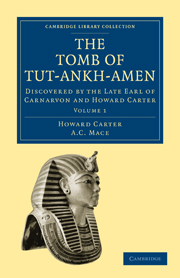Book contents
- Frontmatter
- Preface
- Contents
- LIST OF PLATES
- INTRODUCTION. BIOGRAPHICAL SKETCH OF THE LATE LORD CARNARVON
- CHAPTER 1 THE KING AND THE QUEEN
- CHAPTER 2 THE VALLEY AND THE TOMB
- CHAPTER 3 THE VALLEY IN MODERN TIMES
- CHAPTER 4 OUR PREFATORY WORK AT THEBES
- CHAPTER 5 THE FINDING OF THE TOMB
- CHAPTER 6 A PRELIMINARY INVESTIGATION
- CHAPTER 7 A SURVEY OF THE ANTECAMBER
- CHAPTER 8 CLEARING THE ANTECHAMBER
- CHAPTER 9 VISITORS AND THE PRESS
- CHAPTER 10 WORK IN THE LABORATORY
- CHAPTER 11 THE OPENING OF THE SEALED DOOR
- APPENDIX
- INDEX
- Plate section
- Plate section
CHAPTER 6 - A PRELIMINARY INVESTIGATION
Published online by Cambridge University Press: 07 October 2011
- Frontmatter
- Preface
- Contents
- LIST OF PLATES
- INTRODUCTION. BIOGRAPHICAL SKETCH OF THE LATE LORD CARNARVON
- CHAPTER 1 THE KING AND THE QUEEN
- CHAPTER 2 THE VALLEY AND THE TOMB
- CHAPTER 3 THE VALLEY IN MODERN TIMES
- CHAPTER 4 OUR PREFATORY WORK AT THEBES
- CHAPTER 5 THE FINDING OF THE TOMB
- CHAPTER 6 A PRELIMINARY INVESTIGATION
- CHAPTER 7 A SURVEY OF THE ANTECAMBER
- CHAPTER 8 CLEARING THE ANTECHAMBER
- CHAPTER 9 VISITORS AND THE PRESS
- CHAPTER 10 WORK IN THE LABORATORY
- CHAPTER 11 THE OPENING OF THE SEALED DOOR
- APPENDIX
- INDEX
- Plate section
- Plate section
Summary
I Suppose most excavators would confess to a feeling of awe—embarrassment almost—when they break into a chamber closed and sealed by pious hands so many centuries ago. For the moment, time as a factor in human life has lost its meaning. Three thousand, four thousand years maybe, have passed and gone since human feet last trod the floor on which you stand, and yet, as you note the signs of recent life around you—the half-filled bowl of mortar for the door, the blackened lamp, the finger-mark upon the freshly painted surface, the farewell garland dropped upon the threshold—you feel it might have been but yesterday. The very air you breathe, unchanged throughout the centuries, you share with those who laid the mummy to its rest. Time is annihilated by little intimate details such as these, and you feel an intruder.
That is perhaps the first and dominant sensation, but others follow thick and fast—the exhilaration of discovery, the fever of suspense, the almost overmastering impulse, born of curiosity, to break down seals and lift the lids of boxes, the thought—pure joy to the investigator—that you are about to add a page to history, or solve some problem of research, the strained expectancy—why not confess it?—of the treasure-seeker. Did these thoughts actually pass through our minds at the time, or have I imagined them since? I cannot tell.
- Type
- Chapter
- Information
- The Tomb of Tut-Ankh-AmenDiscovered by the Late Earl of Carnarvon and Howard Carter, pp. 97 - 109Publisher: Cambridge University PressPrint publication year: 2010First published in: 1923



